What Is Wind Farm?
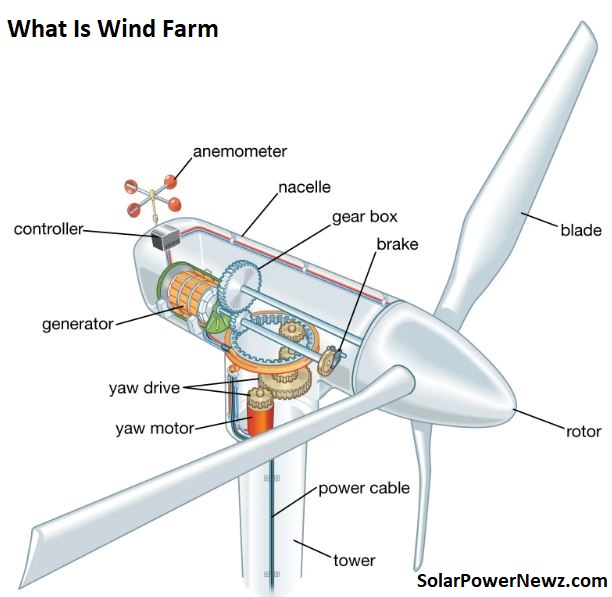
In this article we will discuss about What Is Wind Farm, Definition, Types, And Benefits. A wind farm or wind park, also known as a wind power station or wind power plant, is a set of wind turbines that produce energy in the same location. Wind farms range in size from a few turbines to hundreds of turbines spread across a large area. Wind farms may be built ashore or offshore.
Wind farms are places that feature a significant number of huge wind turbines clustered together. You “harvest” the wind’s energy. These massive turbines resemble enormous windmills.
Hundreds of wind turbines can be spread out over hundreds of kilometres in a huge wind farm. The ground between the turbines can be used for a variety of purposes, including conventional farming. Wind farms can also be found near bodies of water. Winds blowing over lakes or oceans are used there.
Did you know that wind energy is a subset of solar energy? The earth’s shape and spin influence the uneven heating of the atmosphere by the sun, resulting in winds.
Wind farms are built in places that are notoriously windy on a regular basis. The winch turns the turbine blades. The wind energy is then converted into mechanical power via the turbines. The mechanical power is subsequently converted into electricity through generators. This electricity is subsequently distributed to homeowners.
A wind turbine is the polar opposite of a fan. A fan generates wind by using energy. Wind turbines, on the other hand, utilise the wind to generate electricity! When the wind moves a wind turbine’s blades, the blades cause a shaft to turn. The rotating shaft is linked to a generator, which produces power.
You can generate wind energy at home, if I tell you so. Surprising, but true; read the article: How Do You Make a Wind Turbine at Home?
Table of Contents
Types Of Wind Farm
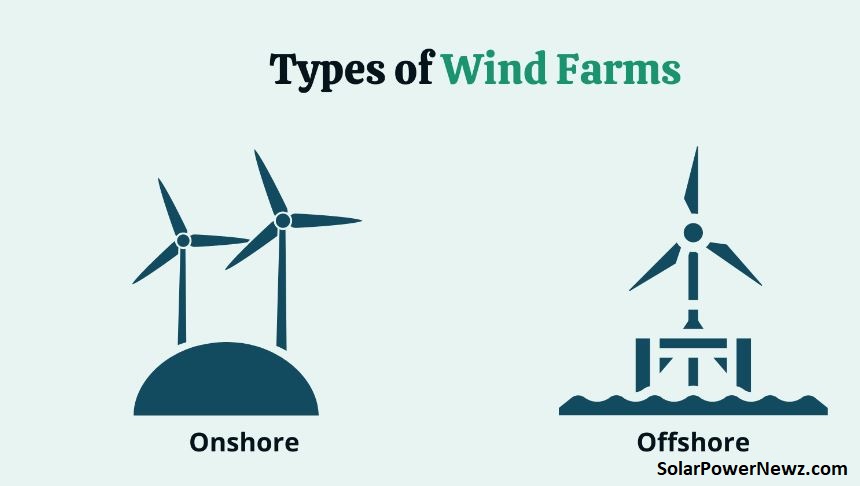
Wind farms are classified into two types.
- Offshore Wind farms
- OnShore Wind Farms
Offshore Wind Farms
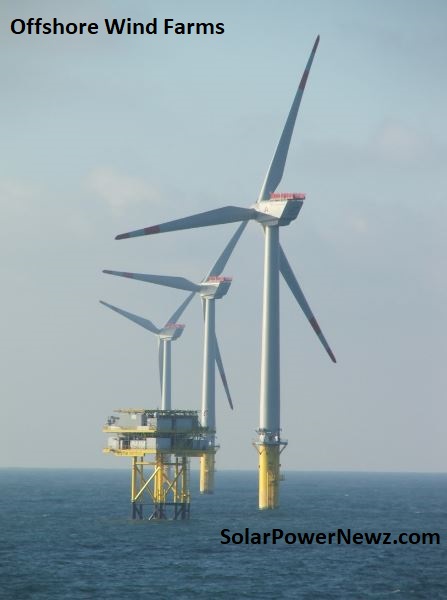
Offshore wind energy is the utilisation of wind farms placed in bodies of water, mainly the ocean, to generate wind energy for electricity generation. Because offshore wind energy has higher wind speeds than on land, it generates more electricity per installed capacity.
Offshore wind energy is a clean and renewable energy source produced by harnessing the strength of the wind on the open seas, where it travels at a faster and more consistent speed than on land due to the lack of impediments.
Megastructures that sit on the seabed and are outfitted with the most recent technological advancements have been installed in order to make the most use of this resource. Learn about the appearance and operation of these true marine giants.
How Offshore Wind Turbines Work in Detail:
- The wind’s force rotates the blades.
- The blades are connected to the nacelle via the hub.
- The low-speed shaft and the blades both rotate at the same speed (7 – 12 turns per minute).
- This speed is increased more than 100 times by the gearbox and sent to the high-speed shaft.
- This speed is sent to the generator through the high-speed shaft (+1,500 revolutions per minute).
- The generator turns the kinetic energy that has been received into electricity.
- The interior of the tower is used to feed down the electricity produced by the generator.
- The converter is responsible for converting direct current to alternating current.
- The transformer boosts the voltage (33 kV – 66 kV) to carry it throughout the wind farm.
- Through undersea cables, the substation receives the electricity.
- At the substation, the electricity is converted to high voltage current (+150 kV).
- Electricity is delivered to households via the distribution network.
Types Of Offshore Wind Turbines
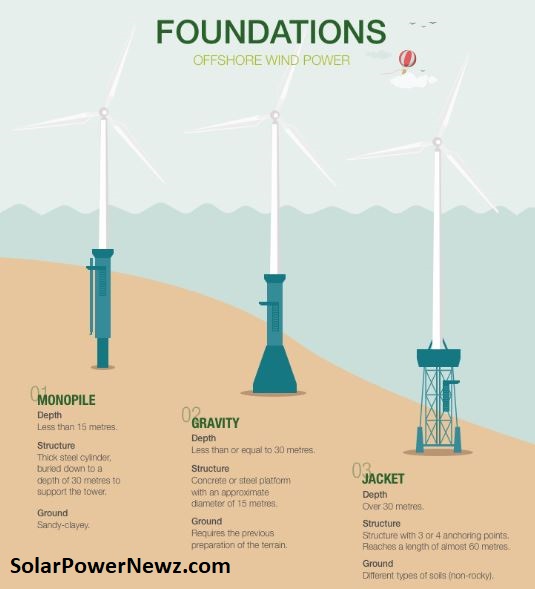
Fixed foundation offshore wind turbines are normally deemed technically practicable in places with less than 50 metres of ocean depth and an average wind speed of more than 7 metres per second (23 feet per second).
1. Fixed Foundation Offshore Wind Turbines
Except for a few experimental projects, practically all offshore wind farms in operation today use turbines with a fixed foundation. Fixed foundation offshore wind turbines are erected in relatively shallow waters of up to 50 to 60 metres in depth.
Underwater structures can be monopile, tripod, or jacketed, with foundations on the sea floor ranging from monopile or multiple piles to gravity bases and caissons. Depending on the depth of the water, offshore turbines require different types of bases for stability.
2. Floating Offshore Wind Turbines
Fixed foundations are uneconomical or physically impossible in places with depths greater than 60-80 m, necessitating the use of floating wind turbines moored to the ocean floor.
3. Vertical-Axis Offshore Wind Turbines
Although the vast majority of onshore and big offshore wind turbines currently built are horizontal axis, vertical axis wind turbines have been proposed for use in offshore sites. Because of the offshore installation’s lower centre of gravity.
In theory, these turbines can be built larger than horizontal-axis turbines, with proposed designs of up to 20 MW per turbine. This has the potential to increase the economies of scale of offshore wind farms. However, there have been no large-scale demonstrations of this technique to date.
What Are The Advantages Of Offshore Wind Energy?
- Offshore wind energy is renewable, limitless, and eco-friendly.
- Offshore, there are more wind resources than on land (up to twice as many as in a medium-sized onshore wind farm).
- Because the visual and aural impact is minimal while offshore, substantially bigger regions can be employed. As a result, offshore wind farms often have installed capacities of several hundred megawatts.
- Offshore wind turbines have substantially bigger unit capacities and sizes than onshore wind turbines due to the ease of sea transport, which has few constraints on cargo and dimensions compared to land transport.
Onshore Wind Farms
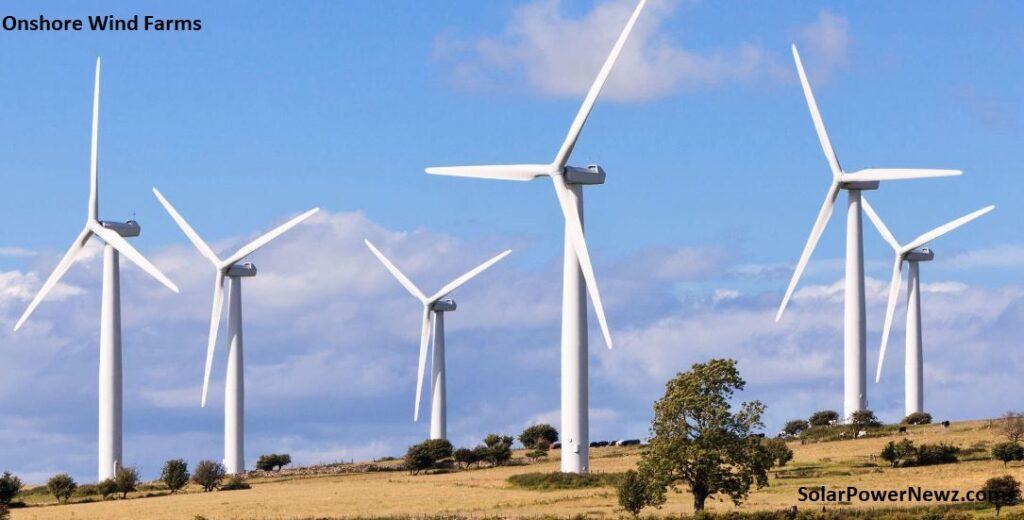
Onshore wind farms are constructions that generate electricity from wind at terrestrial places. To accomplish this, we first develop and construct equipment that can transform kinetic energy from the wind into electricity, which is then converted into usable electricity before being sent to the distribution system.
Wind energy is created by transforming air current movement into electrical energy. Huge wind farms are being created to harness the wind generated on land in order to generate the most power possible from this clean, renewable resource. Let’s go over how it works.
How Does An Onshore Wind Farm Work?
A wind turbine generates electrical energy. For stability and functionality, this structure is supported by reinforced concrete foundations. It has a controller that starts and pauses the turbine based on weather conditions, as well as a device that determines wind direction to ensure proper alignment. The tower has a beacon system with specialised lights and colours that make it extremely visible to air traffic for maximum safety. Its height is determined by the peculiarities of the terrain.
The wind’s power turns the blades, which are designed to catch as much kinetic energy as possible: they can move at speeds as low as 11 kilometres per hour in relatively mild winds. The hub connects the blades to the turbine, which in turn connects to the low-speed shaft, which rotates at the same speed as the blades (between 7 and 12 revolutions per minute).
This speed is multiplied via a gearbox and sent to the high-speed shaft, which rotates at more than 1,500 revolutions per minute. This power is delivered to the generator (in some systems, low-speed generators are directly attached to the slow shaft), where it is turned into electrical energy. It then passes via the converter, which transforms it to alternating current.
Because the electrical energy generated is low voltage, it is delivered to a transformer, which raises the voltage (between 20 and 66 kV) that will be transported through the farm. It is then delivered to the substation, where it is converted into high-voltage power (more than 132 kV). This now-consumable electricity is transmitted via the evacuation line (typically overhead) via a system linked to the distribution network, which leads it to the houses.
Where Can Offshore Wind Farms Be Installed?
Wind farms are typically built in unpopulated rural areas far from towns and cities to avoid disturbing residents.
When determining where to develop a wind farm, various variables must be considered:
- Impact on the environment.
- The area’s energy potential.
- The spatial, temporal, and vertical wind variations across time.
- The site’s geological and geotechnical conditions.
- The location’s environmental, legal, and territorial viability, as well as its accessibility.
Before constructing a wind farm, meteorological techniques and models can be used to evaluate the optimal places for wind turbine installation and to estimate its output capacity over its useful life.
What Are The Benefits Of Onshore Wind Farms?
- They are an endless source of clean, safe, renewable energy.
- They reduce the use of fossil fuels, which aids in the prevention of climate change and the transition to a more sustainable energy system.
- They generate almost no waste and neither harmful gas nor radiation.
- Because they are transportable installations, the site may be restored after the farm is demolished.
- Wind turbines have low maintenance expenses.
- Wind farms have no impact on agriculture or livestock farming in the vicinity of the facility.
- They generate employment. Wind energy in Europe: possibilities for 2030, published by WindEurope in September 2017, predicts that the wind power industry will produce 569,000 employment by 2030.
FAQs.
What Is A Wind Farm Called?
A wind farm or wind park, also known as a wind power station or wind power plant, is a set of wind turbines that produce energy in the same location. Wind farms range in size from a few turbines to hundreds of turbines spread across a large area. Onshore or offshore wind farms are also possible.
What Is Offshore Wind Farm?
Offshore wind energy is the utilisation of wind farms placed in bodies of water, typically the ocean, to generate wind energy for electricity generation. Because offshore wind energy has higher wind speeds than on land, it generates more electricity per installed capacity.
How Do Wind Farms Work?
Wind turbines operate on a simple principle: instead of using electricity to create wind (like a fan does), wind turbines utilise wind to create electricity. The wind moves a turbine’s propeller-like blades around a rotor, which spins a generator and generates power.
What Is The Purpose Of A Wind Farm?
Wind farms are areas that have a large number of large wind turbines clustered together. They “harvest” the wind’s energy.
Do Wind Farms Make Money?
Wind turbines can earn $3000-$10,000 or more per year, depending on their size and kilowatt capacity. Wind farm farmers can preserve their own electricity output while guaranteeing a reduced price for at least 20 years.
What Are 3 Disadvantages Of Wind Energy?
Wind energy has a lot of disadvantages, including unpredictability, wildlife hazards, low-level noise, being unattractive, and having limited areas suitable for wind turbines.
Who Owns The Wind Farms?
The wind turbines occupy slivers of property on the five ranches whose fields they adorn. The wind farm is owned by Avangrid Renewables, which is situated in Portland, Oregon. It is a subsidiary of the Iberdrola Group, a Spanish energy firm.
What Are The 5 Main Parts Of A Wind Turbine?
A wind turbine consists of five major and many auxiliary parts. The tower, rotor, nacelle, generator, and foundation or base are the main components.
What Are 3 Advantages Of Wind Power?
Advantages of Wind Power
- Wind power is cost-effective.
- Wind creates jobs.
- Wind enables U.S. industry growth and U.S. competitiveness.
- It’s a clean fuel source.
- Wind is a domestic source of energy.
- It’s sustainable.
- Wind turbines can be built on existing farms or ranches.
What Is The Lifespan Of A Wind Turbine?
A good quality, a modern wind turbine will generally last for 20 years, although this can be extended to 25 years or longer depending on environmental factors and the correct maintenance procedures being followed. However, the maintenance costs will increase as the structure ages.
How Long Does It Take To Build A Wind Farm?
Construction time is usually very short a 10 MW wind farm can easily be built in two months. A larger 50 MW wind farm can be built in six months.
Are Home Wind Turbines Worth It?
Small wind turbines are a reliable option, whether in the suburbs, living off the grid, or just trying to save costs. They offer sustainable energy that significantly minimizes your carbon footprint.